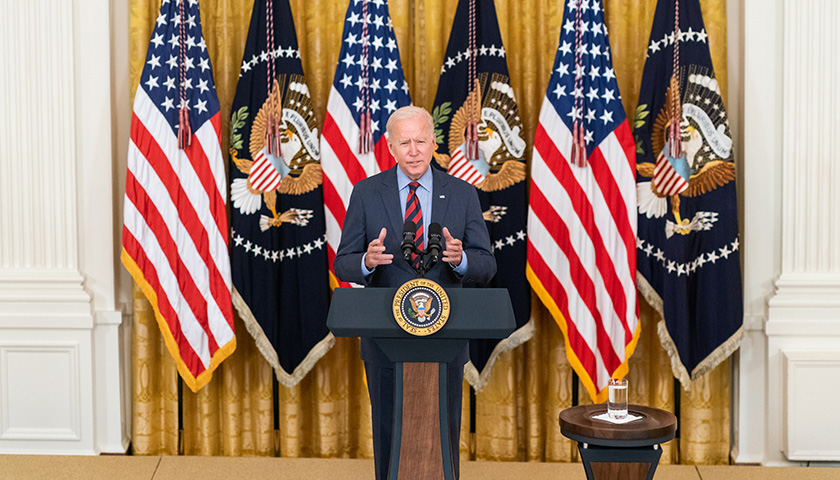by Justin Begley
As congressional Democrats push a $3.5 trillion social spending package, everyone is wondering: “How are we going to pay for that?” To President Joe Biden, the answer is simple: raise taxes.
Included in Biden’s proposed tax plans — erroneously named the American Families Plan — are hikes in personal income tax and capital gains tax rates. The plan would raise the top marginal income tax rate from 37 percent to 39.6 percent and reclassify long-term capital gains and qualified dividends as ordinary income for those with taxable income above $1 million, resulting in a top marginal tax rate of 43.4 percent, according to the Tax Foundation.
Despite the frustration (or excitement) that Americans have towards Biden’s income and wealth tax proposals in the midst of an economic recovery, Americans should be paying closer attention to his other proposals, the American Jobs Plan and the Made in America Tax Plan.
Should these tax plans pass when sent to the House and Senate, corporations would be taxed at a rate of 28 percent rather than the current rate of 21 percent. Further, large corporations that report high profits, but a lower level of taxable income would be subject to a 15 percent minimum tax on book income.
The Biden administration says that the minimum book tax will close the “loophole” that corporations use to pay lower or zero federal income taxes caused by “significant gaps in current tax law.”
But in reality, firms often pay a low amount in federal income taxes because of timing differences of book income and taxable income. When a firm makes a capital investment, it depreciates the value of the asset over the course of its useful life. This could be 5, 10, even 20 years or more, depending on the asset. This is used to calculate book income. However, when calculating taxable income, firms will often deduct the full cost of the asset in the year it was purchased. This creates a timing difference.
These timing differences that allow firms to depreciate large asset purchases provide incentives for firms to continue to invest in capital, which spurs economic growth via increased production and spending in the economy. This 15 percent minimum book tax would almost certainly hold back economic growth. In fact, the Tax Foundation estimates that the tax would lead to a 0.1 percent (~$23 billion) reduction in GDP, 0.2 percent reduction in the capital stock, and 0.1 percent reduction in wages, and 16,000 fewer jobs. Though seemingly small in magnitude, the effects are economically significant.
It’s a similar story for the proposed increase in the corporate income tax rate. The Tax Foundation estimates that raising the corporate income tax from 21 percent to 28 percent would reduce GDP by 0.7 percent (~$160 billion), reduce the capital stock by 1.4 percent, reduce wages by 0.6 perecent, and lead to 138,000 fewer jobs. Analysts at BlackRock also estimate that a 28 percent tax rate would lower the S&P 500 index by 7 percent in 2022, effectively wiping away the returns of more than half of Americans for that year.
Biden’s proposal creates a corporate tax that is the highest among countries in the Organisation for Economic Co-operation and Development. It would severely harm U.S. competitiveness, hold back economic growth, reduce the efficiency and output of firms due to lower capital investment, hurt the wages of working Americans, and cause 154,000 Americans to lose their jobs.
But the consequences could be more severe. Biden ought to ask himself: “Who will bear the burden of my proposed tax increase?”
Most Americans and politicians — falsely — assume that corporations and the wealthy will bear the burden of higher taxes. They figure that it will make the income distribution more “equitable” because the wealthy and corporations are just “paying their fair share.” But is this really true? As it turns out, probably not.
In introductory economics courses, students learn that two parties can bear the burden of a tax, the producer and the consumer, depending on the relative price elasticity of supply and demand.
When supply is more elastic than demand, i.e., consumers are less sensitive to changes in prices than producers, the tax burden falls more heavily on the consumer. When demand is more elastic than supply, i.e., producers are less sensitive to changes in prices, the producer bears more of the tax cost.
The economic literature on corporate taxation provides evidence for the theory. In a 2018 study published in the American Economic Review, German economists examine changes in the German local business tax (LBT) to determine the corporate tax incidence on wages. They find that increases in municipal taxes lead to a reduction in wages and 51 percent of the additional tax burden falls on workers. Low-skilled, young, and female workers — the subgroup that tax increases were presumably intended to help — take on the greatest share of the burden.
Germany is, of course, different from the U.S. but several other studies of the corporate tax incidence on labor obtain similar results.
Before Americans and politicians, including Biden, cry out for corporations and the wealthy to be taxed higher for purposes of “equity” and “fairness,” they ought to pause and realize that tax policy isn’t that simple. It is incredibly complex and often has unforeseeable consequences. Biden’s proposed tax policy will hurt working Americans, particularly those he intends to help with the tax hike. If he sincerely wishes to improve the financial situation of working Americans, he needs to put the breaks on his tax plan and revise.
– – –
Justin Begley is a contributor with Young Voices. He is also an M.S. candidate in Economics at Florida State University. With experience in financial and policy research, his works have appeared in various outlets including the Washington Times, the Detroit News, and Townhall.





